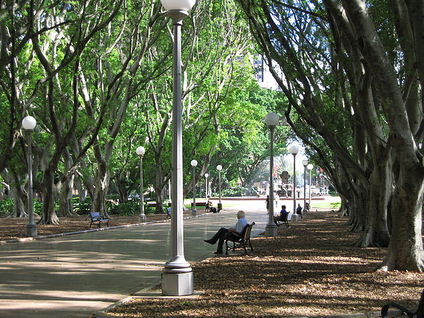Sustainability initiativesInitiatives by topicCommunity energyCommunity involvementCycling activismCritical Mass bicycle rides in Sydney and other cycling related links Open spacesWikipedia: Parks in Sydney: Sydney is well endowed with open spaces, and has many natural areas, and open spaces, even within the city centre. These include the Chinese Garden of Friendship and Hyde Park (which is named after London's Hyde Park). The metropolitan area contains several national parks, including the Royal National Park, the second oldest national park in the world (after Yellowstone National Park), which occupies an area of 132 km². Completing Sydney's wide array of green spaces, the leader is the Royal Botanical Gardens, with its large amount of green spaces, lush plants and colourful flowers. Sustainable transport activismHow the city of Sydney helped decrease car dependencyAustralia's culture of car dependency is creating unnecessary urban congestion, time and financial costs for households and business, and contributing to Australia’s high level of carbon emissions. The city of Sydney introduced a car-sharing policy in 2011 to encourage shared use of vehicles. Car-sharing operators must offer fuel-efficient and low-emissions vehicles, make the cars available via a 24-hour web- and phone-based booking system, and provide a monthly report on the use of car-sharing parking spaces. The policy contains provisions that prevent spaces allocated to car sharing from being sold or transferred to new operators, and there is an annual fee for car-sharing operators to cover the administration costs of the policy. According to the city of Sydney, they currently provide around 700 car-sharing spaces, which are utilized by two operators. As reported by Sydney Media, just five years after the policy was introduced the city has already exceeded its target of signing up 10 percent of households by 2016. Moreover, an average of nine people sign up to the scheme every day, which is utilized by over 26,000 customers — roughly 19,000 residents and 7,000 local businesses. An independent evaluation of the policy's impact was commissioned by the city in 2012. The SGS Economics and Planning study found that car sharing had already saved users $21 million per year, mostly from deferred car purchases amounting to $18.5 million. The policy also contributed to decreased travel times, reduced congestion, and lower carbon emissions. [1] Public transportWikipedia: Public transport in Sydney is provided by an extensive network of public transport operating by modes including road, rail and water transport. According to the 2006 census, in terms of travel to work or study Sydney has the highest rate of public transport usage among the Australian capital cities of 26.3% with more than 80% of weekday trips to/from Central Sydney being made by public transport. According to the New South Wales State Plan, the state has Australia's largest public transport system. The network is regulated by Transport for NSW, which is working towards an integrated network serving Sydney, Newcastle, the Central Coast, the Blue Mountains, Wollongong and the Illawarra. |
News and comment2017 Postcard from Transition Bondi Beach, Australia, May 10 [2] 2016 Sydney students pioneer Australian-first solar apartment project, Dec 2 [3] Do Sydney and Canberra really need to choose between light rail and trees? Apr 25 [4] 2015 Sydney brewery taps community solar, with local govt support, November 3 [5] Interwiki linksWikipedia: Sydney External links
|
